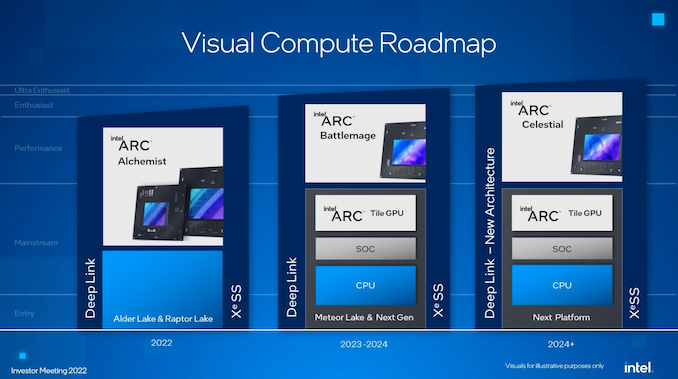As part of Intel’s annual investor meeting taking place today, Raja Koduri, Intel’s SVP and GM of the Accelerated Computing Systems and Graphics (AXG) Group delivered an update to investors on the state of Intel’s GPU and accelerator group, including some fresh news on the state of Intel’s first generation of Arc graphics products. Among other things, the GPU frontman confirmed that while Intel will indeed ship the first Arc mobile products in the current quarter, desktop products will not come until Q2. Meanwhile, in the first disclosure of chip volumes, Intel is now projecting that they’ll ship 4mil+ Arc GPUs this year.
In terms of timing, today’s disclosure confirms some earlier suspicions that developed following Intel’s CES 2022 presentation: that the company would get its mobile Arc products out before their desktop products. Desktop products will now follow in the second quarter of this year, a couple of months behind the mobile parts. And finally, workstation products, which Intel has previously hinted at, are on their way and will land in Q3.
The pre-recorded presentation from Koduri does not offer any further details as to why Intel has their much-awaited Arc Alchemist architecture-based desktop products trailing their mobile products by a quarter. We know from previous announcements that the Alchemist family is comprised of two GPUs, so it may be that Intel is farther ahead on manufacturing and delivering the smaller of the two GPUs, which would be best suited for laptops. Alternatively, the company may be opting to focus on laptops first since it would allow them to start with OEM devices, and then expand into the more complex add-in board market a bit later. In any case, it’s a notable departure from the traditional top-to-bottom, desktop-then-laptop style launches that current GPU titans NVIDIA and AMD have favored. And this means that eager enthusiasts looking for an apples-to-apples look at how Intel’s first high-end GPU architecture fares, we’re going to be waiting a bit longer than initially expected.
Meanwhile, between mobile, desktop, and workstation products, Intel is expecting to ship over 4 million units/GPUs for 2022. To put this in some kind of reference, Jon Peddie Research estimates that the GPU AIB industry shipped 12.7 million boards in Q3’21. Which, pending Q4 numbers being released, would have put the industry as having shipped over 40 million discrete boards altogether over 2021. And while this is a bit of an apples-to-oranges comparison since Intel is counting both AIB desktop and mobile products, it does underscore the overall low volume of Alchemist chips that Intel is expecting to sell this year. Assuming AMD and NVIDIA deliver as many chips in 2022 as they did in 2021, Intel will be adding at most no more than another 10% to the overall volume of GPUs sold.
On the whole, this isn’t too surprising given both current manufacturing constraints and Intel’s newcomer status. The company is using TSMC’s N6 process to fab their Alchemist GPUs, and TSMC remains capacity constrained during the current chip crunch; so how many wafers Intel could hope to get was always going to be limited. Meanwhile as a relative newcomer to the discrete GPU space – a market that has been an NVIDIA/AMD duopoly for most of the past two decades – Intel doesn’t have the customer inertia that comes from offering decades of products. So even if Alchemist products perform very well relative to the competition, the company still needs time to grow into AMD and NVIDIA-sized shoes and to woo over the relatively conservative OEM base.
Celestial Architecture Under Development: Targeting Ultra Enthusiast Market
Along with the update on Alchemist, Koduri’s presentation also offered a very (very) brief update on Celestial, Intel’s third Arc architecture. Celestial is now under development, and at this point, Intel is expecting it to be their first product to address the ultra-enthusiast market (i.e. the performance crown). GPUs based on the Celestial architecture are expected in the “2024+” timeframe; which is to say that at this far out Intel doesn’t seem to know for sure if they’ll be 2024 or 2025 products.
Covering the gap between Alchemist and Celestial will be Battlemage, the second of Intel’s Arc GPU architectures. Battlemage now has a 2023-2024 release date, with Intel expecting the architecture to improve performance over Alchemist to the point where Battlemage will be competitive in the enthusiast GPU market – but not quite reaching the ultra-enthusiasts that Celestial will.
Finally, by virtue of this disclosure, it would seem that Battlemage will be the first Arc GPU architecture to make it into Intel’s CPUs. The company has it slated to be implemented as a tile on Meteor Lake CPUs, making this the crossover point where Intel’s current Xe-LP GPU architecture finally gets retired in favor of a newer GPU architecture.




